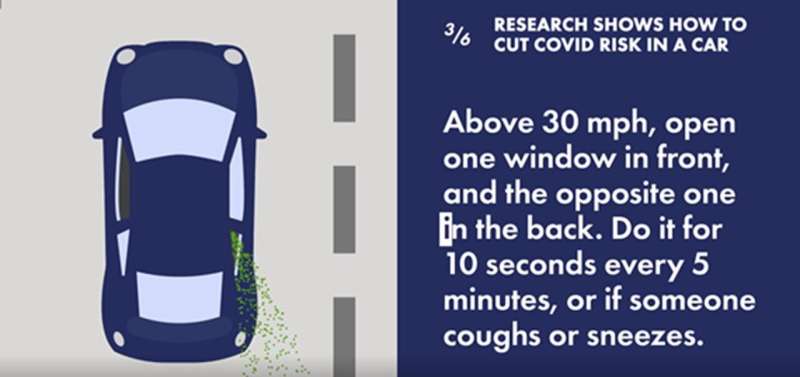Researchers at Swansea University have laid out a step-by-step guide to reduce exposure to the coronavirus when traveling by car, including some important and surprising advice on opening windows.
The research team, supported by the Institute for Innovative Materials, Processing and Numerical Technologies (IMPACT), identified key COVID-19 safety measures for car journeys through their study on optimal car ventilation.
Findings suggest:
- all windows should be open for car travel below 30 mph
- however, once speed increases above this, it is more effective for only two opposite windows, one in the front and one in the back, to be opened—occasionally—to create a diagonal flow of air. For example, driver side window and rear passenger side window.
Project lead Professor Chenfeng Li says, "When a COVID-19 patient coughs, saliva containing the virus is expelled in the form of droplets. Large-size droplets fall quickly to the ground, while small-size droplets evaporate quickly. These droplets of saliva disappear in the air in seconds, but the small-size droplets release the contained virus into the air after evaporation, which can survive up to an hour and remain infectious.
The virus can survive on surfaces and remain infectious for different periods of time, dependent on the surface type. It is the dispersing of these small droplets that we focused on in our study."
The study produced simulations that demonstrate the effects of a driver coughing in a moving car at various speeds. The small saliva droplets disperse in varying formations depending on which windows are open.
Professor Li said, "This car transmission study gives some interesting findings. Based on our scenario, and unsurprisingly, optimal ventilation comes from having all four windows open for city driving (up to 30mph).
However, perhaps surprisingly, the diagonal flow from the driver side window to the rear passenger side window is the most effective option for getting the virus out of the car when driving above 30mph. This is because a sustained and dominant air flow from the front to the rear is formed when two diagonally opposite windows are open and the other two are closed.
At higher driving speed, this strong diagonal air flow is more effective to discharge the virus particles out of the car than the turbulent air flow formed by opening all four windows.
The process is so effective that it's only necessary to do it for 10 seconds at a time, every 5 to 10 minutes, or whenever somebody coughs or sneezes."
We can also conclude that sitting at the front is a lot safer than sitting at the back, because of the increased contamination within the rear part of the car due to the fact that the in-car air flow predominantly moves from the front to the rear, trapping some of the virus particles in the rear zone."
As part of the research, the use of face masks was also studied. The results showed that wearing a face covering reduces the emission of the virus by 90% and that the intake of the virus by passengers was reduced by 70%.
Professor Li concluded: "At a time when restrictions are lifting across the UK and we will be traveling more, it is important to take steps to ensure we are limiting any potential exposure to the virus. This study sets out our recommendations for optimal ventilation and reduced transmission."
Professor Li sits on the Welsh Government Coronavirus (COVID-19) Technical Advisory Group. His findings supported recent guidelines for taxis and private hire vehicles.




Recommended Comments
There are no comments to display.
Join the conversation
You can post now and register later. If you have an account, sign in now to post with your account.
Note: Your post will require moderator approval before it will be visible.